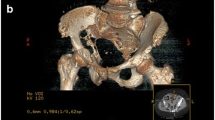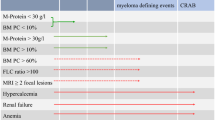Abstract
Multiple myeloma is a plasma cell dyscrasia producing bone lytic lesions. In recent years, a wide spectrum of therapeutic approaches are available to treat the disease: an accurate therapy assessment has, therefore, become of utmost importance. In this field, imaging is becoming a cornerstone, especially in association with clinical parameters. Among imaging procedures, FDG PET/CT is recognized to provide reliable information, achieved in a very safe and fast procedure. The literature has produced very concordant results from different groups assessing the value of FDG PET/CT as a prognostic factor in general and in therapy assessment, but some issues remain regarding a standardization of image interpretation especially in borderline cases. So far, no data regarding nor other imaging compounds and the use of hybrid tomographs PET/MR are available to define therapy assessment in PET.


Similar content being viewed by others
References
Kyle RA. Diagnostic criteria of multiple myeloma. Hematol Oncol Clin North Am. 1992;6:347–58.
Rajkumar SV, et al. International myeloma working group updated criteria for the diagnosis of multiple myeloma. Lancet Oncol. 2014;15:e538–48.
Durie BGM. The role of anatomic and functional staging in myeloma: description of Durie/Salmon plus staging system. Eur J Cancer. 2006;42:1539–43.
Mahnken AH, et al. Multidetector CT of the spine in multiple myeloma: comparison with MR imaging and radiography. AJR Am J Roentgenol. 2002;178:1429–36.
Avva R, Vanhemert RL, Barlogie B, Munshi N, Angtuaco EJ. CT-guided biopsy of focal lesions in patients with multiple myeloma may reveal new and more aggressive cytogenetic abnormalities. AJNR Am J Neuroradiol. 2001;22:781–5.
Tirovola EB, et al. The use of 99mTc-MIBI scanning in multiple myeloma. Br J Cancer. 1996;74:1815–20.
Pace L, et al. Different patterns of technetium-99m sestamibi uptake in multiple myeloma. Eur J Nucl Med. 1998;25:714–20.
Fonti R, et al. Bone marrow uptake of 99mTc-MIBI in patients with multiple myeloma. Eur J Nucl Med. 2001;28:214–20.
Falcone C, Cipullo S, Sannino P, Restuccia A. Whole body magnetic resonance and CT/PET in patients affected by multiple myeloma during staging before treatment. Recenti Prog Med. 2012;103:444–9.
Bauerle T, et al. Multiple myeloma and monoclonal gammopathy of undetermined significance: importance of whole-body versus spinal MR imaging. Radiology. 2009;252:477–85.
Baur-Melnyk A, et al. Whole-body MRI versus whole-body MDCT for staging of multiple myeloma. AJR Am J Roentgenol. 2008;190:1097–104.
Lecouvet F, et al. Long-term effects of localized spinal radiation therapy on vertebral fractures and focal lesions appearance in patients with multiple myeloma. Br J Haematol. 1997;96:743–5.
Spinnato P, et al. Contrast enhanced MRI and 18F-FDG PET-CT in the assessment of multiple myeloma: a comparison of results in different phases of the disease. Eur J Radiol. 2012;81(12):4013–8 doi: 10.1016/j.ejrad.2012.06.028. Epub 2012 Aug 24.
Rahmouni A, et al. Detection of multiple myeloma involving the spine: efficacy of fat-suppression and contrast-enhanced MR imaging. AJR Am J Roentgenol. 1993;160(5):1049–52.
Zamagni E, et al. A prospective comparison of 18F-fluorodeoxyglucose positron emission tomography-computed tomography, magnetic resonance imaging and whole-body planar radiographs in the assessment of bone disease in newly diagnosed multiple myeloma. Haematologica. 2007;92:50–5.
Zamagni E, et al. Positron emission tomography with computed tomography-based diagnosis of massive extramedullary progression in a patient with high-risk multiple myeloma. Clin Lymphoma Myeloma Leuk. 2014;14:e101–4.
Cavo M, et al. Role of 18F-FDG PET/CT in the diagnosis and management of multiple myeloma and other plasma cell disorders: a consensus statement by the International Myeloma Working Group. Lancet Oncol. 2017;8(4):e206–e217.
Boellaard R. Standards for PET image acquisition and quantitative data analysis. J Nucl Med. 2009;50(Suppl 1):11S–20S.
Boellaard R, et al. FDG PET/CT: EANM procedure guidelines for tumour imaging: version 2.0. Eur J Nucl Med Mol Imaging. 2015;42:328–54.
Zamagni E, et al. Prognostic relevance of 18-F FDG PET/CT in newly diagnosed multiple myeloma patients treated with up-front autologous transplantation. Blood. 2011;118:5989–95.
Bartel TB, et al. F18-fluorodeoxyglucose positron emission tomography in the context of other imaging techniques and prognostic factors in multiple myeloma. Blood. 2009;114:2068–76.
Usmani SZ, et al. Prognostic implications of serial 18-fluoro-deoxyglucose emission tomography in multiple myeloma treated with total therapy 3. Blood. 2013;121:1819–23.
Nanni C, et al. The value of 18F-FDG PET/CT after autologous stem cell transplantation (ASCT) in patients affected by multiple myeloma (MM): experience with 77 patients. Clin Nucl Med. 2013;38:e74–9.
Patriarca F, et al. The role of positron emission tomography with 18F-Fluorodeoxyglucose integrated with computed tomography in the evaluation of patients with multiple myeloma undergoing allogeneic stem cell transplantation. Biol Blood Marrow Transplant. 2015; doi:10.1016/j.bbmt.2015.03.001.
Dimitrakopoulou-Strauss A, et al. Prediction of progression-free survival in patients with multiple myeloma following anthracycline-based chemotherapy based on dynamic FDG-PET. Clin Nucl Med. 2009;34:576–84.
Kumar S, et al. International myeloma working group consensus criteria for response and minimal residual disease assessment in multiple myeloma. Lancet Oncol. 2016;17:e328–46.
Derlin T, et al. Comparative diagnostic performance of (1)(8)F-FDG PET/CT versus whole-body MRI for determination of remission status in multiple myeloma after stem cell transplantation. Eur Radiol. 2013;23:570–8.
Mesguich C, et al. State of the art imaging of multiple myeloma: comparative review of FDG PET/CT imaging in various clinical settings. Eur J Radiol. 2014;83:2203–23.
Nanni C, et al. Image interpretation criteria for FDG PET/CT in multiple myeloma: a new proposal from an Italian expert panel. IMPeTUs (Italian myeloma criteria for PET USe). Eur J Nucl Med Mol Imaging. 2016;43:414–21.
McDonald JE, et al. Assessment of Total lesion glycolysis by 18F FDG PET/CT significantly improves prognostic value of GEP and ISS in myeloma. Clin Cancer Res. 2016; doi:10.1158/1078-0432.CCR-16-0235.
Lasnon C, Enilorac B, Popotte H, Aide N. Impact of the EARL harmonization program on automatic delineation of metabolic active tumour volumes (MATVs). EJNMMI Res. 2017;7:30.
Nanni C, et al. 11C-choline vs. 18F-FDG PET/CT in assessing bone involvement in patients with multiple myeloma. World J Surg Oncol. 2007;5
Lapa C, et al. 11C-Methionine-PET in multiple myeloma: correlation with clinical parameters and bone marrow involvement. Theranostics. 2016;6:254–61.
Okasaki M, et al. Comparison of (11)C-4′-thiothymidine, (11)C-methionine, and (18)F-FDG PET/CT for the detection of active lesions of multiple myeloma. Ann Nucl Med. 2015;29:224–32.
Zhu W, Dang Y, Ma Y, Li F, Huo L. 11C-Acetate PET/CT monitoring therapy of multiple myeloma. Clin Nucl Med. 2016;41:587–9.
Author information
Authors and Affiliations
Corresponding author
Ethics declarations
Ethical approval
This article does not contain any studies with human participants performed by any of the authors.
Rights and permissions
About this article
Cite this article
Nanni, C., Zamagni, E. Therapy assessment in multiple myeloma with PET. Eur J Nucl Med Mol Imaging 44 (Suppl 1), 111–117 (2017). https://doi.org/10.1007/s00259-017-3730-4
Received:
Accepted:
Published:
Issue Date:
DOI: https://doi.org/10.1007/s00259-017-3730-4




